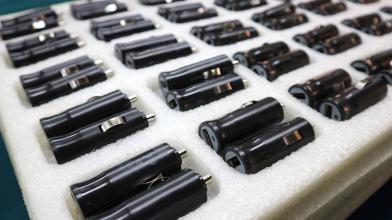
The disruptions from these events can initially feel like they are out of your control, however there are still actions you can take to help minimize your risk.
Current Event #1: Chinese New Year 2022
Chinese New Year (CNY) arrives every year sometime during the months of January and February. This year the national public holiday begins February 1st and continues until February 6th, 2022.
Chinese New Year is such an important holiday within China that many businesses shutdown for the period of time to enjoy it. Many people travel very far to return to their hometowns to celebrate the holiday with family.
How does CNY affect overseas manufacturing?
Many manufacturing factories within China also close during this timeframe to allow their employees to travel and celebrate with family. Some may close an additional week before or after the public holiday.
Therefore, factory closures can range from 1 - 3 weeks for Chinese New Year. It then takes about 2 weeks for the factories to get back to the prior output before the holiday.
One week before closing for the holiday, factories may put new projects on the backburner in order to push out their current workload before the closure.
After the holiday, there is an expected drop in a factory’s returning workforce since many workers do not return to work at the same factory. This employment drop requires extra time after the CNY closure for a factory to hire and train new workers before it is back up to full capacity.
With the ramp down prior to the Chinese New Year holiday, the vacation time, and any training for new factory workers after the holiday, you can expect delays to your product’s manufacturing schedule for upwards of 4 to 5 weeks.
How to Avoid Manufacturing Delays from the CNY Holiday
- Confirm with your factory on your order and delivery dates before the holiday. Any quoted timelines may not have taken the holiday closures and delays into account.
- Lead times continue to be extended beyond the norm, so to buffer your own timeline, add 3 - 4 weeks and attempt to place your order as early as possible.
- Follow-up with your supplier immediately after the holiday on your lead time. Depending on the amount of time needed for the factory to get back to full production, your standard lead time may be temporarily impacted.
Current Event #2: Beijing Winter Olympics
Coinciding with CNY 2022, the Winter Olympics kick-off in Beijing on February 4th.
Beijing is the first city ever to host both the Summer Olympics (2008) and now the Winter Olympics (2022). By observing how the city prepared for the 2008 Summer Olympics, we can make similar predictions for this time around.
How do the 2022 Olympics in Beijing affect manufacturing?
In 2008, many of the factories in and around the city were shut down in order to improve the air quality. Vehicle emissions were also regulated through the city. We’re already seeing similar environmental policies put into place for the upcoming Winter Olympics.
In addition, the area is currently experiencing rolling blackouts. Factories may be shut down temporarily until power is restored.
Beyond the blackouts, in an effort to conserve the amount of power consumed, the city may put into place temporary holds on consumption to allow for the Olympic Games to least be affected.
Your supply chain will be impacted if you have parts from one of the factories that may be temporarily closed - either from pollution regulation, consumption regulation, or a rolling blackout.
Lastly, any traffic restrictions or controls put in place within Beijing to reduce vehicle emissions during this time could also cause a delay in transit of parts that are merely traveling through the area.
How to Minimize Supply Chain Disruption from the 2022 Winter Olympics
- Know the physical location of not only your factory but its suppliers.
It’s highly likely that you already know what city your factory is in. But, are you aware of any additional suppliers’ location? Take your due diligence one step further and learn about your factory’s suppliers. This can help you have a bigger picture of how you may be impacted. - Communicate with your factory to learn if they are expecting any temporary closures from the Winter Olympics.
- If in doubt, add a few weeks to your lead time as the Olympics will span over 2 weeks from February 4th through the 20th.
Current Event #3: China’s Zero Tolerance Covid Strategy (ongoing)
As we begin 2022, we enter our third year of the Covid-19 pandemic. China’s response to the pandemic focuses on a strict zero tolerance policy to mitigate transmission among its people.
This policy has led to short-noticed quarantines of large areas, which then limit available workers. Staff shortages are causing businesses to close temporarily, congested seaports, and canceled flights. This is not a new current event, but an ongoing one.
How to Continue to Navigate Covid-19 Effects on the Electronics Supply Chain
- Secure additional stock. It’s no longer about having stock “just in time” for your builds, it’s about having stock “just in case.”
- Build your BOM to also show alternate components. Have a second or third option if your first choice for a particular component is showing a long lead time.
- Review and restructure your order and inventory management process.
You may want to consider adopting a staggered ordering process in order to ship early and often. This means your goods will be shipped over time and therefore be at different stages within your logistics chain. If an unexpected event occurred (like the cargo jam at L.A. and Long Beach ports this past October), this approach allows some of your product to still move toward your customer rather than being completely hung up if it was in one consolidated shipment.
At the beginning of the year, we always see some supply chain delays in order to accommodate the Chinese New Year holiday. This year in 2022, there are additional current events, like the Beijing Winter Olympics and the ongoing Covid-19 pandemic, that are adding to the disruption.
This may seem like the situation is completely out of your control. However, there are actions you can take to best understand how the situation is specifically affecting your business. Through communication, transparency, and adjusting your own strategy, you’ll be able to make the best decisions to propel your business forward during these current events.


